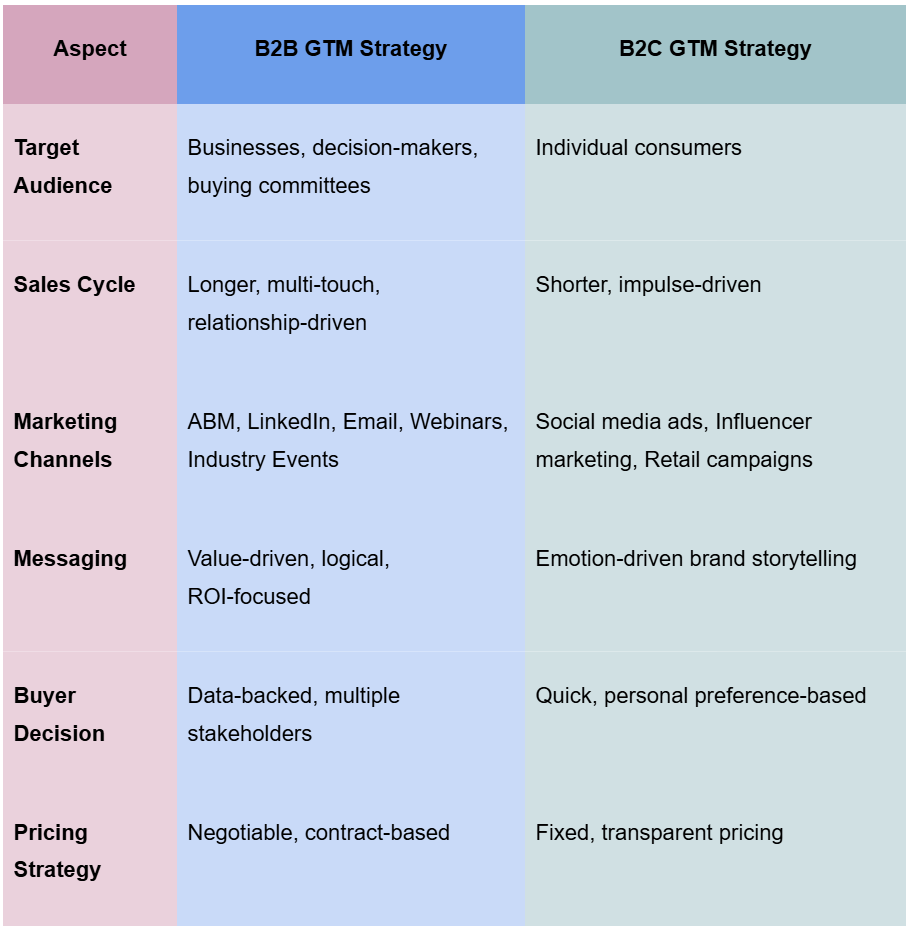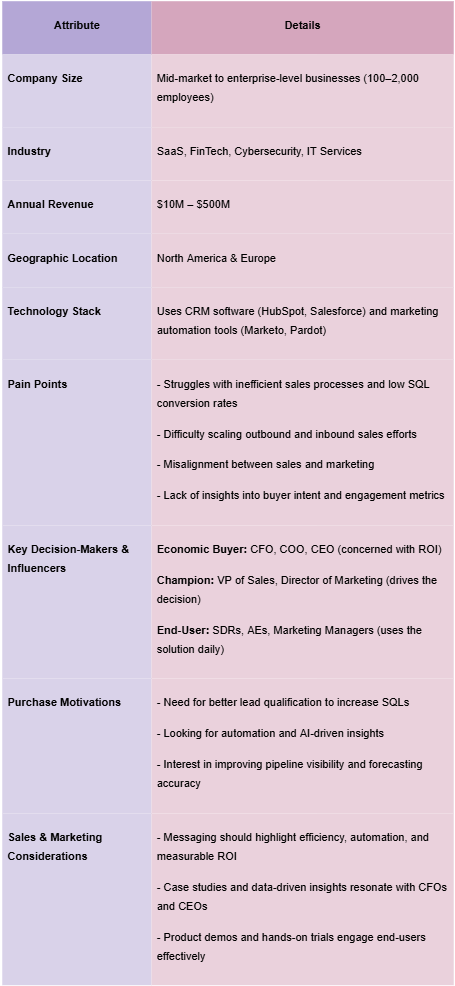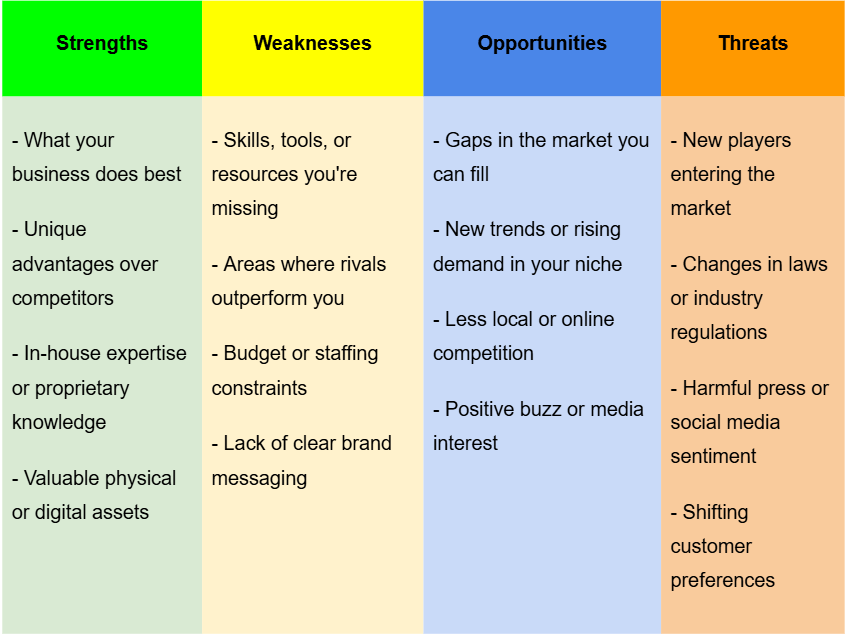Important tool updates - Learn more
- Learn
-
Articles
Read about influencer marketing
-
Growthnotes - Newsletter
Insights for the modern marketer
The B2B e-commerce market was worth $7.4 trillion in 2022 and is projected to grow to $36.1 trillion by 2031.
The competition is heating up, and if your go-to-market (GTM) strategy isn’t optimized, you risk losing market share to brands that are already executing at full speed.
The truth? A great product isn’t enough. You need the right sales, marketing, and positioning strategy to cut through the noise.
Whether you're launching a new B2B product or refining your existing GTM strategy, getting this right can be the difference between a breakout success and a failed launch.
In this blog, we’ll break down:
P.S. Struggling to get your B2B product in front of the right audience? A weak GTM strategy leads to low conversions and wasted ad spend. inBeat Agency helps brands refine their positioning, optimize influencer marketing, and launch high-performing GTM campaigns that actually drive revenue. Book a free strategy call now!
B2B GTM strategies are critical for product launches, scaling efforts, and entering new markets—especially in a competitive $7.4T+ industry projected to grow 5x by 2031.
B2B GTM vs. B2C GTM: B2B involves longer sales cycles, multiple stakeholders, and ROI-focused messaging; B2C is fast, emotional, and mass-market driven.
Who needs it: Startups, SaaS companies, large enterprises, manufacturers, and distributors all benefit from a strategic GTM plan.
Key benefits: Faster revenue, improved targeting, stronger customer retention, and a distinct competitive edge.
7-Step GTM Process:
Real-world examples:
Key takeaway: Successful GTM execution hinges on alignment, data, and constant iteration—positioning your product is as important as the product itself.
Pro tip: Consider partnering with GTM-focused agencies like inBeat to accelerate execution, avoid missteps, and maximize ROI.
A B2B Go-To-Market (GTM) strategy is a comprehensive plan that helps a B2B company successfully bring its product or service to market and reach high-value accounts. It aligns sales efforts, marketing tactics, and distribution channels to engage target accounts and drive revenue growth.
You’ve got the basics of a B2B GTM strategy now. But how does it differ from B2C? Let’s break it down in the next section.
A B2B Go-To-Market strategy focuses on high-value accounts, longer sales cycles, and a dedicated sales team, while B2C is all about quick conversions, emotional triggers, and mass appeal.
Below, we have shared a quick comparison for you:

So, who actually needs a solid B2B Go-To-Market strategy? Let’s find out:
If you think it’s only for startups, think again. A good GTM strategy is the backbone of any B2B company looking to scale, break into new markets, or maximize revenue growth.
It’s for:
Now that we know who needs a B2B Go-To-Market strategy, let’s explore what a strong B2B GTM strategy brings to the table:
Even the best product offerings can struggle in a competitive market without a clear plan. To cut through the noise and drive real results, you need a strategy that works. Research shows that companies with a well-defined GTM market plan are 50% more likely to succeed than those without one.
To help you build a high-impact B2B GTM strategy, inBeat experts have outlined a step-by-step guide designed for maximum success.
A winning B2B GTM strategy knows exactly who to target: the high-intent buyers who need your solution the most.
Without a clear Ideal Customer Profile and buyer personas, even the best sales strategy can miss the mark. Get this right, and your entire sales funnel becomes more effective.
In B2B sales, multiple stakeholders influence purchasing decisions. It’s a mix of C-level executives, managers, and end-users, each playing a different role in the purchasing decision. Understanding this helps tailor your sales strategy effectively.
Once you know who they are, define their pain points, challenges, and purchase motivations. What customer pain are they looking to solve? How does your product or service fit into their customer journey?
Also, keep in mind the key difference between users and economic buyers. End-users rely on your product daily, but final approval often comes from CEOs, CFOs, or procurement officers.
A targeted strategy that speaks to both drives higher conversion rates and a more effective sales funnel.
To narrow down your target market, focus on key factors:
B2B Ideal Customer Profile (ICP) Sample

Now that you know your ideal customer, it’s time to look at the market conditions. A strong go-to-market strategy needs customer insight and a clear market position.
Start with a SWOT analysis. Identify strengths, weaknesses, and gaps in the current market. Study competitors’ pricing, sales channels, and product positioning. See where they win and where they miss the mark.
The goal is to find opportunities. What are competitors overlooking? What customer pain remains unsolved? Pinpoint these gaps, and you gain a competitive advantage.
A B2B company that knows the market strategy framework can stand out fast. Next, let’s build a Unique Value Proposition that makes your brand impossible to ignore.

Your research is done. Now, it’s time to define what sets you apart.
Without a clear UVP, your sales team will struggle to convince potential customers why they should choose you over competitors.
Your UVP should speak directly to customer pain and buyer personas. What makes your product offerings essential? How does it solve real customer demands better than anything else?
Keep it simple, powerful, and results-driven.
Once your UVP is clear, shape your messaging. Use whitepapers, industry reports, and competitor gap analysis to validate your value.
💡Pro tip: Read customer reviews of competitor products on G2, Capterra, Trustpilot, and Reddit to uncover common pain points and unmet needs. A new TrustRadius survey revealed 77% of buyers reported reading user reviews, making it a great place to start. Use these insights to craft a UVP that directly addresses what your target customers are missing elsewhere.
With your UVP locked in, it’s time to choose the right sales and marketing channels to get in front of the right audience.
The right approach depends on your sales cycle and the buyer's journey.
Inbound strategies like content marketing, SEO, webinars, and influencer collaborations work best for longer sales cycles, where potential customers need education before making a decision.
Outbound efforts like cold emails, LinkedIn outreach, and direct calls are ideal for high-value accounts that require a personal touch.
For faster conversions, paid ads on LinkedIn and Google help you reach decision-makers actively looking for solutions. Conversely, partnerships with resellers, affiliates, and industry leaders help you expand your presence and build trust in new markets.
We suggest not relying solely on a single marketing channel. Instead, use a diverse approach for better engagement, stronger brand positioning, and a more effective sales strategy.
💡 Pro tip: Not all marketing channels work equally. Use UTM tracking in Google Analytics to measure which sales efforts drive the most SQLs and double down on effective channels.
Driving traffic is one thing; turning that traffic into customers is another. Now that your sales and marketing channels are in place, it’s time to capture leads and keep them engaged.
Start with high-converting landing pages and lead magnets like eBooks, free trials, and product demos. These attract potential customers and move them into your sales funnel. For businesses looking to scale faster, you can also attract leads to supplement organic lead generation and accelerate pipeline growth.
For example, Mindtickle, a sales readiness platform, provides an eBook titled "Sales Training Cheat Sheet" to support sales professionals.
Once leads are in, don’t let them go cold. Use multi-touch nurturing; email sequences, remarketing, and personalized follow-ups to guide them through the buyer journey.
A strong lead generation and nurturing plan increases conversion rates, customer retention, and lifetime value.
💡 Pro tip: Automate the grind! Use CRM and marketing automation tools like HubSpot and Salesforce to track leads, personalize outreach, and streamline your sales process for faster conversions. For advanced outbound prospecting, AISDR.shop offers AI-driven SDR solutions to fully automate personalized outreach, helping you generate SQLs and book meetings at scale without adding headcount.
Next, let’s equip your sales team with the tools they need to close deals faster
Leads mean nothing if your sales team isn’t ready to close.
Equip your sales reps with the tools they need to convert prospects into customers: pitch decks, objection-handling scripts, and case studies so they can confidently engage with high-value accounts.
Train them in consultative and value-based selling to focus on solving customer pain rather than just pushing a sale.
Alignment is key. Your marketing team and sales team should work together to ensure a smooth handoff of leads and a consistent customer experience.
Step 6: Build a Strong Sales Enablement Strategy. A strong sales enablement strategy means faster sales cycles, higher conversion rates, and better customer satisfaction. To make sales enablement stick, centralize customer and market research so teams can find, trust, and reuse it. Robust enterprise knowledge management systems use semantic search, auto-tagging, and curated collections to activate insights at the point of decision, in CRM, Slack, or sales decks, reducing duplicate work and speeding time-to-decision across regions. Pair this with regular insight digests and usage analytics to keep reps aligned on messaging that actually converts.
💡Pro tip: Equip your sales reps with a pre-launch objection-handling guide. Since your product is new, potential customers will have concerns. Address common doubts like, "Why should we trust a new solution?" with strong value-driven responses.
A winning B2B GTM strategy isn’t set in stone; it’s an ongoing process. After setting your sales and marketing efforts in motion, tracking performance is the final step.
Keep an eye on key metrics like SQLs, MQLs, conversion rates, Customer Acquisition Cost (CAC), and Customer Lifetime Value (CLV). These numbers reveal what’s working and what needs improvement.
inBeat.co’s free marketing calculators help you analyze CTR, CPA, ROAS, and more so you can optimize with precision.
Test, tweak, and refine. Use A/B testing to optimize your marketing tactics, messaging, and sales process.
Moreover, leverage AI and analytics tools to track customer preferences and fine-tune your approach in real time.
The brands that scale the fastest are the ones that analyze, adapt, and optimize continuously.
P.S. Launching a B2B GTM strategy can feel like a lot, but you don’t have to figure it out alone. You can collaborate with expert Go-to-Market agencies. They help you refine your positioning, sales process, and demand generation to ensure a seamless launch while you stay focused on growth.
Most B2B GTM strategies fail due to weak marketing execution, poor sales alignment, and lack of post-sale focus.
Here’s how to avoid common mistakes:
One of the biggest GTM mistakes is treating content as an afterthought. 90% of B2B buyers research online (up to 2-7 websites) before making a purchase. This means your marketing efforts need to be educational and consistent.
Don’t overspend at launch; spread your budget wisely.
Track CAC vs. CLV to refine spending and drive sustainable growth.
Closing a deal isn’t the finish line; it’s the start of retention.
When you neglect post-sale customer support, it leads to high churn and lost revenue. Set up dedicated onboarding, proactive check-ins, and ongoing customer success programs.
Use email sequences, live chat, and loyalty offers to keep customers engaged and increase customer lifetime value (CLV).
When sales and marketing teams operate in silos, leads slip through the cracks and revenue is lost.
Align both teams with a shared CRM, lead-scoring system, and clear handoff process.
Ensure that marketing generates high-quality leads while sales reps are equipped with the right messaging to close deals faster.
A seamless workflow means higher conversion rates and faster sales cycles.
You’ve got the framework, best practices, and key strategies, but how do successful B2B companies execute their GTM strategies in real life?
Let’s take a look at brands that have mastered their go-to-market approach and what makes them stand out.
One of our clients, Miro, a visual collaboration platform, scaled rapidly by focusing on product-led growth (PLG), community-driven adoption, and influencer marketing. Instead of relying solely on traditional sales efforts, Miro made its product easy to try, share, and adopt.
Key GTM strategies:
Slack, a cloud-based team communication platform, disrupted traditional workplace communication by offering a faster, more connected alternative to email.
Instead of targeting C-suite executives, it focused on employees and teams to spread organically within companies. This bottom-up strategy fueled word-of-mouth marketing and made Slack a workplace essential before leadership even considered enterprise-wide adoption.
Key GTM strategy:
Gong, an AI-powered revenue intelligence platform, first targeted individual sales reps with a startup-style brand. As the company expanded, it realized that purchasing decisions come from C-suite executives and revenue leaders. To scale, Gong reworked its brand, messaging, and marketing to connect with business decision-makers.
Key GTM strategy shifts:
A B2B go-to-market strategy is more than just launching a product. It is about winning customers, creating demand, and scaling efficiently. Without the right positioning, sales alignment, and marketing execution, even great products struggle to gain traction. Success comes from continuous refinement, testing, and adaptation.
Key takeaways
If you’re looking to launch, optimize, or scale your B2B product, a strong GTM strategy is a must. inBeat Agency helps brands fine-tune their positioning, influencer marketing, and paid campaigns to drive real growth. Book a free strategy call now!
A B2B go-to-market strategy focuses on longer sales cycles, multiple decision-makers, and value-driven messaging, while a B2C GTM strategy is geared toward shorter sales cycles, emotional triggers, and mass-market appeal. B2B relies on account-based marketing (ABM), sales enablement, and relationship-building, whereas B2C uses impulse-driven purchases, social proof, and high-volume marketing channels.
A strong B2B GTM strategy includes defining ICP and buyer personas, market research, clear UVP and messaging, sales and marketing alignment, lead generation, and data-driven optimization. These elements ensure efficient targeting, strong positioning, and scalable growth.
A well-structured GTM strategy attracts high-quality leads, improves sales efficiency, and increases customer retention. It ensures your marketing and sales efforts are aligned, reduces wasted spend, and helps scale revenue with data-driven insights.